- Snow mountain ecology -
In many mountain areas, ecological processes are strongly influenced by snow (Mori et al. 2007; Mori & Komiyama 2008). For example, snow is a deciding factor on what kind of plants will grow at the boundary between the subalpine area and alpine area (ecotone). Especially, in a heavily snowy environment, disturbance agents related to snow, such as avalanche, snow glide and creep, determine the growth and survival of trees (Kajimoto et al. 2002; Seki et al. 2005; Mori & Hasegawa 2007; Mori et al. 2008). However, Knowledge on the forest in snowy environments is still very limited. It may be reasonable to assume that forests in mountainous areas will be tremendously altered due to climate change. Therefore it is intriguing to research how the forest ecosystem survives in this unique environment in order to possibly predict the influence of future climate change on ecosystems in mountainous areas.
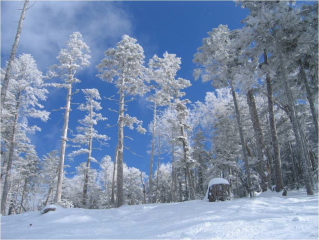
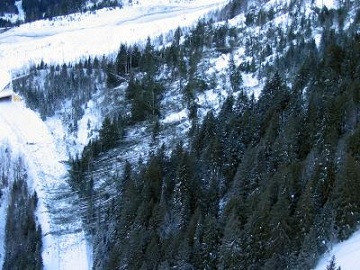
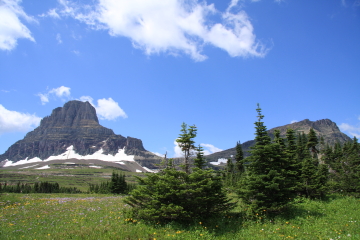
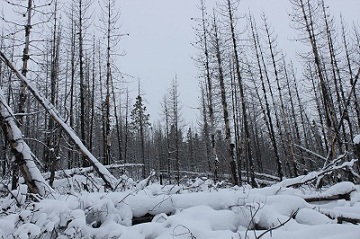
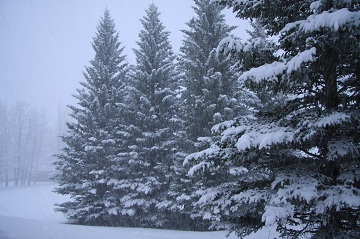



The studies were conducted to elucidate how Abies mariesii, a dominant subalpine conifer species in the snowy side of Japan, can live in the tough environment associated with disturbances and stress incurred by heavy snow. Plants are sessile so that they have some ability to acclimate to their surrounding environments (Mori & Niinemets 2010). In the case of Abies mariesii in the Tateyama Range, Japan, it turned out that its unique morphological and physiological characteristics help this species to survive in a snowy environment and to overcome its sessile burden (Mizumachi & Mori 2007; Mori & Hasegawa 2007; Mori & Mizumachi 2009).
The focus was also put on Abies amabilis, a dominant species in mountain areas in the Pacific Northwest of the United States. It is the species most phylogenetically related to Abies mariesii. This species can survive in heavy snow by having high morphological plasticity according to a study done in the Cascade Mountain Range, US (Mori et al. 2008).
In conclusion, there is now some clarification on how tree species can grow and survive in heavy snow conditions, one of the primary factors, to determine plant growth in mountainous areas. Future studies will concentrate on how these conifer species adapt to stresses related to snow by focusing on their genetic and morphological properties.


References
Seki T, Kajimoto T, Sugita H, Daimaru H, Ikeda S, Okamoto T (2005) Mechanical damage on Abies mariesii trees buried below the snowpack. Arctic Antarctic and Alpine Research 37:34-40.
Kajimoto T, Seki T, Ikeda S, Daimaru H, Okamoto T, Onodera H (2002) Effects of snowfall fluctuation on tree growth and establishment of subalpine Abies mariesii near the upper forest-limit of Mt. Yumori, northern Japan. Arctic Antarctic and Alpine Research 34:191-200.
Mori AS, Niinemets Ü. (2010) Plant responses to heterogeneous environments: Scaling from shoot modules and whole plant functions to ecosystem processes. Ecological Research 25: 691-692.
Mori AS, Mizumachi E. (2009) Within-crown structural variability of dwarfed mature Abies mariesii in a snowy subalpine parkland in central Japan. Journal of Forest Research 14: 155-166.
Mori AS, Komiyama A. (2008) Differential survival among life-stages contributes to co-dominance of Abies mariesii and Abies veitchii in a subalpine old-growth forest. Journal of Vegetation Science 19: 239-244.
Mori AS, Mizumachi E, Sprugel DG. (2008) Morphological acclimation to understorey environments in Abies amabilis, a shade- and snow-tolerant conifer species of the Cascade Mountains, Washington, USA. Tree Physiology 28: 815-824.
Mori A, Hasegawa SF. (2007). Structural characteristics of Abies mariesii saplings in a snowy subalpine parkland in central Japan. Tree Physiology 26: 141-148.
Mori AS, Mizumachi E, Sprugel DG. (2007). Possible impacts of changing snow regimes on growth and distribution of conifer species in high elevation ecosystems. Proceedings of the International Symposium "Asian Collaboration in IPY 2007-2008", National Institute of Polar Research, pp 201-204.
Mizumachi E, Mori AS. (2007) Current-year shoots and branches structural variations within the crown of Abies mariesii growing in a forest-meadow ecotone developed on Tateyama Mountain Range in central Japan. Proceedings of the International Symposium "Asian Collaboration in IPY 2007-2008", National Institute of Polar Research, pp 205-207.